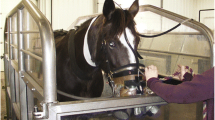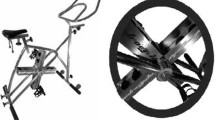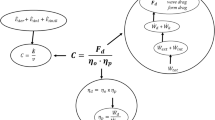Abstract
The total net metabolic power output (\( \dot{E} \), kW) required to scull a traditional, flat hull boat—the “Bissa”, 9.02 m long and weighting about 500 kg including the crew—was assessed at different constant speeds (ν) ranging from 2.44 to 3.75 m s−1. \( \dot{E} \) increased with the speed: \( \dot{E} \) = 0.417 × e 0.664v; r 2 = 0.931. The amount of metabolic energy spent per unit distance (C, J m−1) to move the “Bissa”, calculated by dividing \( \dot{E} \) by the corresponding ν, was a linear function of ν: C = 0.369 ν –0.063; r 2 = 0.821. The hydrodynamic resistance met by the boat in the water—drag (D, N)—was estimated by analysing the decay of the reciprocal of ν as a function of time measured during several spontaneous deceleration tests carried out in still water and by knowing the total mass of the watercraft plus crew. D increased as a square function of speed: D = 12.76 v 2. This allowed us to calculate the drag efficiency (ηd), as the ratio of D to C: ηd increased from 8.9 to 13.7% in the range of the speeds tested. The “Bissa” turned out to be as economical as other flat hull, traditional watercrafts, such as the bigger Venetian gondola, and her ηd was similar to that of other modern and traditional watercrafts.





Similar content being viewed by others
References
Bilo D, Nachtigall W (1980) A simple method to determine drag coefficients in aquatic animals. J Exp Biol 87:357–359
Capelli C (1999) Physiological determinants of best performances in human locomotion. Eur J Appl Physiol 80:298–307. doi:10.1007/s004210050596
Capelli C, Donatelli C, Moia C, Valier C, Rosa G, di Prampero PE (1990) Energy cost of sculling a Venetian gondola. Eur J Appl Physiol 60:175–178. doi:10.1007/BF00839154
Capelli C, Zamparo P, Cigalotto A, Francescato MP, Soule RG, Termin B, Pendergast DR, di Prampero PE (1995) Bioenergetics and biomechanics of front crawl swimming. J Appl Physiol 78:385–393
Capelli C, Schena F, Zamparo P, Dal Monte A, Faina M, di Prampero PE (1998) Energetics of best performances in track cycling. Med Sci Sports Exerc 30:614–624. doi:10.1097/00005768-199804000-00021
Celentano F, Cortili G, di Prampero PE, Cerretelli P (1974) Mechanics aspects of rowing. J Appl Physiol 36:642–647
Daniel TL (1984) Unsteady aspects of aquatic locomotion. Am Zool 24:121–134
di Prampero PE (1986) The energy cost of human locomotion on land and in water. Int J Sports Med 7:55–72
di Prampero PE, Cortili G, Celentano F, Cerretelli P (1971) Physiological aspects of rowing. J Appl Physiol 31:853–857
di Prampero PE, Capelli C, Pagliaro P, Antonutto G, Girardis M, Zamparo P, Soule RG (1993) Energetics of best performances in middle distance running. J Appl Physiol 74:2318–2342. doi:10.1063/1.354717
Holmer I (1972) Oxygen uptake during swimming man. Acta Physiol Scand 407(suppl):1–55
Kjendlie PL, Stallman RK (2008) Drag characteristics of competitive swimming children and adults. J Appl Biomech 24:35–42
Minetti AE, Pinkerton J, Zamparo P (2001) Form bipedalism to bicyclism: evolution in energetics and biomechanics of historical bicycles. Proc R Soc Lond B Biol Sci 268:1351–1360. doi:10.1098/rspb.2001.1662
Pendergast DR, Bushnell D, Wilson DR, Cerretelli P (1989) Energetics of kayaking. Eur J Appl Physiol 59:377–386. doi:10.1007/BF02389808
Pendergast DR, Zamparo P, di Prampero PE, Capelli C, Cerretelli P, Termin A, Craig A Jr, Bushnell D, Paschke D, Mollendorf J (2003) Energy balance of human locomotion in water. Eur J Appl Physiol 90:377–386. doi:10.1007/s00421-003-0919-y
Sargeant AJ, Jones DA (1995) The significance of motor unit variability in sustaining mechanical output of muscle. In: Gandevia S et al (eds) Neural and neuromuscular aspects of muscle fatigue. Plenum, New York, pp 323–338
Secher NH (1993) Physiological and biomechanical aspects of rowing. Sports Med 15:24–42. doi:10.2165/00007256-199315010-00004
Tesch P, Pihel K, Wilson G, Karlson J (1976) Physiological investigation of Swedish elite canoe competitors. Med Sci Sports Exerc 8:214–218. doi:10.1249/00005768-197600840-00002
Toussaint HM, Beek PJ (1992) Biomechanics of competitive front crawl swimming. Sports Med 13:8–24. doi:10.2165/00007256-199213010-00002
Vogel S (1996a) Flow at fluid-fluid interfaces. In: Vogel S (ed) Life in moving fluids: the physical biology of flow, 2nd edn. Princeton University Press, Princeton, pp 382–385
Vogel S (1996b) Unsteady flows. In: Vogel S (ed) Life in moving fluids–The physical biology of flow, 2nd edn. Princeton University Press, Princeton, pp 362–364
Woledge RC, Curtin NA, Homsher E (1985) Energetic aspects of muscle contraction. Academic, London
Zamparo P (2003) Optimization and transmission efficiency in human locomotion, Doctoral Thesis, Department of Exercise and Sport Sciences, Manchester Metropolitan University, UK
Zamparo P, Capelli C, Guerrini G (1999) Energetics of kayaking at submaximal and maximal speeds. Eur J Appl Physiol 80:542–548. doi:10.1007/s004210050632
Zamparo P, Pendergast DR, Termin B, Minetti AE (2002) How fins affect the economy and efficiency of human swimming. J Exp Biol 205:2665–2676
Zamparo P, Carignani G, Plaino P, Sgalmuzzo B, Capelli C (2008) Energy Balance of locomotion with pedal-driven watercraft. J Sports Sci 26:75–81. doi:10.1080/02640410701305420
Acknowledgments
The assistance of Ms. Jenny Mac Donald and Ms. Giuliana Cerutti and the cooperation of the Public Administration of the town of Peschiera del Garda, Verona, Italy are gratefully acknowledged. We heartily thank the rowers of the rowing club Remiera of Peschiera del Garda, Verona, Italy without whom this study could not have been carried out.
Author information
Authors and Affiliations
Corresponding author
Appendix
Appendix
The drag of the boat with the crew was measured by applying the method proposed by Bilo and Nachtigall (1980). This method, originally developed to estimate the floating drag and the drag coefficient (C D) of penguins gliding underwater, is based on the analysis of the spontaneous deceleration. In the following paragraphs, a short description of the approach is reported.
Water drag (D) is described by the following equation:
where A (m2) is the characteristic area of the moving object in water, ρ is the water density (kg m−3) and ν (m s−1) is the speed of the moving object.
In turn, C D can be expressed, by manipulating Eq. 3, as:
During spontaneous deceleration of the boat in the water, the reciprocal of the speed (ν−1) is a linear negative function of the time t of deceleration. Indeed, in this context, the inertial force F(t) always counterbalances D:
According to the second principle of the Newtonian dynamics, F(t) is given by:
where, m is the overall mass of the object and a is the acceleration—negative acceleration in this case: a = dv/dt. Since, at the speeds investigated the present study—i.e., at rather large values of the Reynold’s number, D is adequately expressed by Eq. 3, the combination of Eqs. 5 and 6 yields:
Equation 7 is a differential non-linear equation that, however, can be simplified as follows: we can describe a(t) proportional to the square of the speed ν:
where
By integrating Eq. 8, we easily obtain the following equality:
where 1/y 0 = v o at t = 0, i.e., the initial speed at the beginning of the deceleration. Equation 10 is liable to be easily transformed into a linear equation:
where y(t) = 1/ν (t). The slope c is obviously obtained by fitting the data pairs of t i and v i recorded during the first 10–13 s of spontaneous deceleration by means of a linear equation. Provided we know m, A and ρ of the water, the dimensionless C D can be now calculated as:
In the present investigation m was the overall mass of the boat with oars and full crew (489.4 kg), A, the characteristic area of the object, was the maximal frontal submerged area of the boat, (0.092 m2) and ρ was the distilled water density (998 kg m−3) prevailing at a water temperature of 21°C. Therefore, D of the boat could be finally estimated by means of Eq. 3 assuming that it was strictly proportional to the square of the speed of progression.
Rights and permissions
About this article
Cite this article
Capelli, C., Tarperi, C., Schena, F. et al. Energy cost and efficiency of Venetian rowing on a traditional, flat hull boat (Bissa). Eur J Appl Physiol 105, 653–661 (2009). https://doi.org/10.1007/s00421-008-0949-6
Accepted:
Published:
Issue Date:
DOI: https://doi.org/10.1007/s00421-008-0949-6




